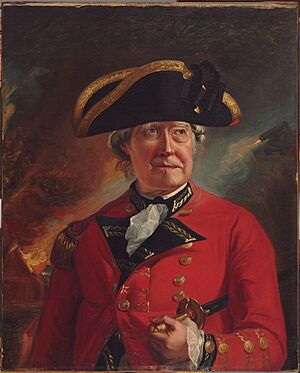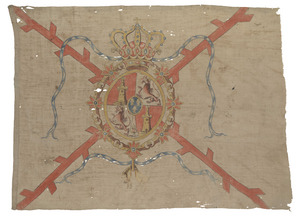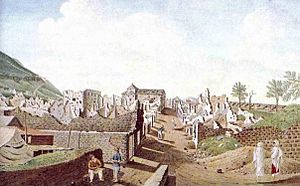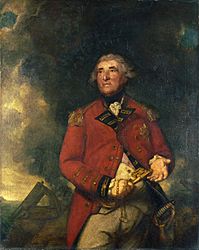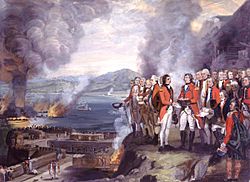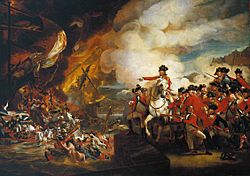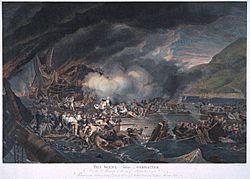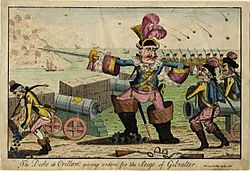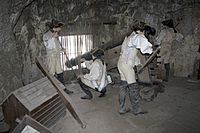Great Siege of Gibraltar facts for kids
Quick facts for kids Great Siege of Gibraltar |
|||||||
|---|---|---|---|---|---|---|---|
| Part of the American Revolutionary War | |||||||
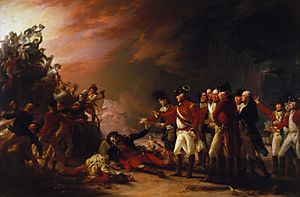 The Sortie Made by the Garrison of Gibraltar, John Trumbull |
|||||||
|
|||||||
| Belligerents | |||||||
| Commanders and leaders | |||||||
| Strength | |||||||
| 7,500 12 gunboats |
65,000 47 ships of the line 10 floating batteries 7 xebecs 40 gunboats |
||||||
| Casualties and losses | |||||||
| 333 killed 138 wounded 536–1,034 sick and dead from disease |
6,000+ killed, wounded, captured and missing Unknown sick and dead from disease 1 ship of the line captured 10 floating batteries destroyed |
||||||
| 196 civilians killed 800 civilians dead from disease |
|||||||
The Great Siege of Gibraltar was a long fight where Spain and France tried to take Gibraltar from the British. This happened during the American Revolutionary War, which was also known as the War of the American Revolution. It was the biggest battle of that war, with the most soldiers involved.
The American war mostly ended in October 1781. But the fight for Gibraltar continued until September 1782. The siege finally stopped in February 1783, when peace talks began.
Spain joined the war on June 16, 1779, helping France and the American colonies. Their main goal was to capture Gibraltar from the British. The British soldiers in Gibraltar, led by George Augustus Eliott, were surrounded from June 1779 to February 1783.
At first, only the Spanish, led by Martín Álvarez de Sotomayor, blockaded Gibraltar. But their blockade failed because two supply convoys got through easily. The first was led by Admiral George Rodney in 1780. The second was led by Admiral George Darby in 1781.
In 1781, Spain planned a big attack. But the Gibraltar soldiers made a surprise attack in November. They destroyed many of the Spanish cannons and forts.
Since the Spanish couldn't defeat the British or stop supplies, French forces joined them. De Crillon took command in early 1782. After a quiet period, the French and Spanish gathered more cannons, ships, and troops.
A "Grand Assault" was launched on September 18, 1782. This huge attack involved 60,000 men, 49 warships, and 10 new, special floating batteries. They were fighting against only 5,000 British defenders. The attack was a huge failure for Spain and France, with many losses. This was the largest battle of the war by far.
The final sign of defeat for the allies came in October 1782. A vital British supply convoy, led by Admiral Richard Howe, got past the enemy fleet. It reached the British soldiers in Gibraltar.
The siege was finally lifted on February 7, 1783. This was a clear victory for the British. The siege also played a part in ending the American Revolutionary War. The Peace of Paris negotiations depended on news from Gibraltar, especially during its most intense moments.
At three years, seven months, and twelve days, it is the longest siege ever faced by the British Armed Forces.
Contents
Why the Siege Happened
Gibraltar's History and Importance
The Rock of Gibraltar was first fortified with the Moorish Castle in 710 AD. It was attacked many times during the Middle Ages. In 1704, British and Dutch forces captured Gibraltar. Britain officially gained control in 1713, after the Peace of Utrecht treaty.
Spain tried to get Gibraltar back in 1727, but failed. After that war, Spain built forts to cut Gibraltar off from the mainland.
In 1738, a disagreement about trade between Europe and the Americas led to the War of Jenkins' Ear. Britain and Spain prepared for battle near Gibraltar, but no major fighting happened there. Peace returned in 1748.
Later, King Charles III of Spain signed an alliance with King Louis XV of France in 1761. France was already fighting Britain in the Seven Years' War. So, Britain declared war on Spain. Again, there was no fighting at Gibraltar. The peace treaty in 1763 returned some lands to Spain. It also gave most of France's North American colonies to Britain.
The American War and Spain's Goals
After years of peace, France and Spain wanted to fight Britain again. They hoped to get back their lost colonies. The American War of Independence in 1775 gave them this chance.
France and Spain first helped the American rebels with money and weapons. France officially joined the war in October 1778. On April 12, 1779, Spain signed a treaty with France. They agreed to help each other get back land from Britain.
Spain then declared war on Britain on June 16. Spain's main goal was to take Gibraltar. The agreement with France said they wouldn't make peace until Gibraltar was back in Spanish hands. Britain was busy with the war in America, so Gibraltar seemed easy to capture. Spain thought taking Gibraltar would be a quick win. Then, they planned to invade Great Britain. This would give them a strong position to get their lost colonies back.
Who Fought in the Siege?
- Spanish Commanders:
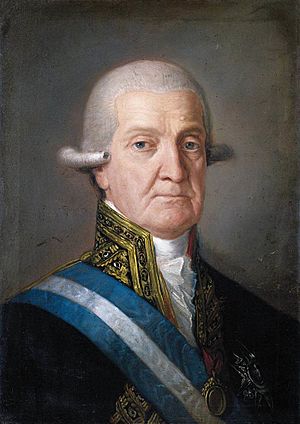

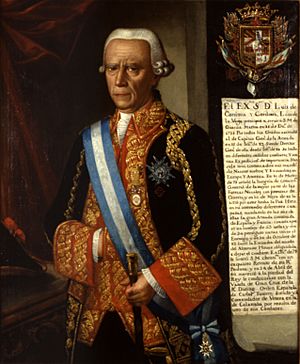
- British Commanders:

The Spanish blockade was led by Martín Álvarez de Sotomayor. The Spanish ground forces had about 14,000 men. This included the Royal Guards and the Walloon Guards. They also had artillery and cavalry. Antonio Barceló commanded the ships blocking the bay. He used xebecs and gunboats from his base in Algeciras.
A fleet of 11 warships and two frigates was placed in the Gulf of Cadiz. This fleet, led by Luis de Córdova y Córdova, aimed to stop British supplies. French help was small at first. But in 1781, more French soldiers arrived.
The British garrison in 1778 had 5,382 soldiers. They were led by General Eliott. All the defenses were made stronger. Eliott also started building new forts. The most important new fort was the King's Bastion. It had 26 heavy guns and barracks for soldiers. The Grand Battery protected the main entrance to Gibraltar.
Eliott increased the number of guns in the forts. Many soldiers helped the artillery. The garrison also included soldiers from Hanover and Corsica. Eliott also formed a unit of sharpshooters. The Royal Navy had only a few ships, but one old warship, HMS Panther, was used as a floating battery. The frigate HMS Enterprise and twelve gunboats were also there.
The British had expected an attack for a while. They had received more soldiers and supplies by ship. Preparations increased after France joined the war in 1778. The long-awaited siege began when Spain joined the war.
British troops included:
- 12th Regiment of Foot
- 39th Regiment of Foot
- 56th Regiment of Foot
- 58th Regiment of Foot
- 65th Regiment of Foot
- 72nd Regiment of Foot (Royal Manchester Volunteers)
The Siege Begins
On June 16, 1779, Spain declared war on Great Britain. A blockade of Gibraltar started right away. On July 6, 1779, British ships fought Spanish vessels bringing supplies. Several Spanish ships were captured, and the fighting began.
The Spanish and French fleets blocked Gibraltar from the sea. On land, a huge army built forts, trenches, and gun batteries. They planned to attack from these positions.
Hard Times for the British
As winter 1779 arrived, food became very scarce for the British soldiers. Bread was almost impossible to get. It was only given to the sick and children. Salted meat and biscuits became the main food. Sometimes, they got a small amount of rice.
Fuel ran out, so fires were hard to make. They used old ship timbers from the harbor, but these were salty. Because of the lack of fresh food, many soldiers got scurvy. General Eliott asked London for help. As winter continued, food portions were cut even more. Despite this, the soldiers stayed hopeful. They believed supplies would arrive by sea.
The Spanish had to use many soldiers and ships for the siege. This delayed their plan to invade England.
First Supplies Arrive
In December 1779, a large group of supply ships sailed from England to Gibraltar. They were protected by 21 warships led by Admiral George Rodney. On their way, they captured a Spanish convoy on January 8, 1780. They used these captured goods to supply Gibraltar.
The Spanish sent a fleet to stop Rodney, but they didn't know how strong his fleet was. Rodney defeated the Spanish fleet at the Battle of Cape St. Vincent. He captured five warships and more supplies. Rodney's fleet easily got through the Spanish blockade. They reached Gibraltar on January 25, 1780. They brought 1,052 more soldiers and plenty of supplies. This cheered up the British soldiers. But as soon as Rodney's fleet left, the siege continued.
The British kept fighting off every attack. Both sides fired cannons at each other. By the end of summer, food was low again, and scurvy returned.
On June 7, 1780, Spanish fireships attacked the two largest British ships in Gibraltar's harbor. Warning shots alerted the British. An intense bombardment slowed the fireships. Some sank, but others kept coming. Spanish warships waited outside the harbor. British sailors used small boats to pull the fireships away from their ships.
Second Supplies Arrive
During the second winter, the British faced hunger, disease, and the enemy. By March, things were serious. Soldiers and civilians had very little food. The Spanish blockade was working. Only a few small ships got through, carrying not enough supplies.
On April 12, 1781, Vice Admiral George Darby's fleet arrived. It had 29 warships protecting 100 supply ships from England. They entered the bay despite the Spanish fleet. The Spanish were angry and started a huge cannon attack. They caused much damage to the town. But the South Mole, where ships unloaded, was safe.
About 1,000 civilians left Gibraltar with Darby on April 21. This meant fewer people for the soldiers to feed. The fleet left without trouble, slipping past the Spanish fleet. The British now had plenty of food, gunpowder, guns, and ammunition.
Since they couldn't starve the British out, the French and Spanish planned more attacks. They gathered a large army and fleet. The Spanish also built new cannon batteries across the narrow strip of land connecting Gibraltar to the mainland.
On June 9, a British cannon hit a major Spanish gunpowder storage. It exploded, followed by many smaller explosions. The Spanish lines were in chaos as soldiers tried to put out fires. But they soon got back to building batteries. By late 1781, the Spanish had 114 cannons and mortars.
The Surprise Attack (Sortie)
By November, hunger was again a threat. Spanish deserters told the British that a huge attack was planned. General Eliott decided to make a surprise night attack on the Spanish and French. He wanted to hit them before their big assault.
On November 27, 1781, the night before the planned attack, the British made their move. About 2,435 soldiers and 99 officers took part. They were in three groups, armed with axes and fire-starting tools. Around 2:00 AM, they marched towards the enemy lines.
The British charged the Spanish guards and stormed their positions. They used bayonets to fight the Spanish defenders. The British took over the eastern part of the Spanish forts. One group of Hanoverian soldiers got lost in the dark. They accidentally found themselves at the base of a huge Spanish mortar battery. They decided to attack it anyway. After heavy fighting, they captured the position.
The British then destroyed supplies, ammunition, weapons, and forts. They also spiked the guns, making them useless. They set fire to the ammunition, and the siege works burned. Soon, Spanish cavalry appeared, but they did not charge. The Spanish were not ready for a British surprise attack.
After completing their mission, the British went back inside their forts. Only two British soldiers were killed, and 25 were wounded. The Spanish lost over 100 men, including 30 prisoners. The British caused about two million pounds worth of damage. They destroyed 14 months of Spanish work and much ammunition.
This surprise attack delayed the big Spanish assault for several months. During this time, the British started building tunnels through the Rock of Gibraltar. This was dangerous work, done by hand with gunpowder blasts. They also invented a new cannon mount, the Koehler Depressing Carriage. This allowed cannons to fire downwards, taking advantage of the Rock's height.
In March, news arrived that the British in Minorca had surrendered. This lowered morale in Gibraltar. But life continued with supplies from merchants who got past the blockade. Portuguese ships brought lemons, wine, and vegetables. They also gave valuable information about the Spanish.
French Forces Arrive

After Minorca surrendered in February 1782, French forces came to help the Spanish at Gibraltar. French engineers arrived, and Louis de Crillon took command. He replaced Álvarez de Sotomayor, who now led only the Spanish soldiers. Both sides hoped for new ideas to win the siege. French ships joined the Spanish navy to strengthen the blockade. They decided to build special floating batteries. The British saw these large ship hulls being brought into the Bay of Gibraltar.
French soldiers who arrived after the siege of Mahon included:
- Régiment de Lyonnais (2 Battalions)
- Régiment de Bretagne (2 Battalions)
- Régiment d'Augoumois (2 Battalions)
- Régiment Royal-Suédois (2 Battalions)
- Régiment de Bouillon (2 Battalions)
With more troops and ships, more guns and mortars arrived for the Spanish. Their siege lines moved closer to Gibraltar. A new Spanish battery, the Mahon, was built quickly. It was hit many times by British guns, causing heavy losses.
Then, there was a quiet period in the siege during the summer. On June 11, a Spanish shell exploded inside a British gunpowder storage. This caused a huge explosion, killing fourteen soldiers.
Peace Talks and Gibraltar's Role
In March, the British Parliament voted to stop fighting an offensive war against America. This was because of the British defeat at Yorktown. News of Minorca's surrender and losses in the West Indies caused the British government to fall. The new government began peace talks.
Even though fighting against America stopped, the war continued elsewhere, including Gibraltar. Gibraltar became a key part of the peace talks. France, allied with Spain, could not make peace without Spain's agreement. Spain wanted Gibraltar back. Both sides wanted to capture Gibraltar quickly to gain an advantage in the talks.
John Jay, an American peace negotiator, understood how important the Gibraltar siege was. He knew that if Gibraltar fell, it would affect the peace terms.
Destroying Spanish Batteries
In early September, the Spanish moved their lines even closer. General Eliott suggested firing red-hot cannonballs at the Spanish lines. These "hot potatoes" were heated in furnaces and fired at the dry wooden defenses.
At 7:00 AM on September 8, 1782, the British started firing. They focused on the western part of the Spanish siege works. Within hours, the results were clear. The Mahon battery and nearby forts caught fire. Other batteries were badly damaged.
The bombardment was a huge success. It caused great damage and at least 280 Spanish and French casualties. The red-hot shot worked so well that furnaces were installed right next to the British batteries.
The Grand Assault
The allies realized that their blockades had failed. An attack by land seemed impossible. So, they came up with a new plan. A group of special battery ships would attack the British land batteries. They would fire many shots to destroy them. Then, soldiers would attack from the land siege works. More troops would land from the Spanish fleet.
The French engineer Jean Le Michaud d'Arçon designed the floating batteries. He said they would be 'unsinkable' and 'unburnable'. They were meant to attack from the sea, while other batteries fired from land.
The floating batteries had very thick wooden armor. It was one meter wide, packed with wet sand. Water was pumped over them to prevent fires. Old cables also helped stop cannonballs. The guns were only on one side. Ten floating batteries, with 150 guns in total, would be supported by warships.
On September 13, 1782, the French and Spanish launched their huge attack. There were 5,260 soldiers on ten floating batteries. These batteries had 138 to 212 heavy guns. The combined Spanish and French fleet had 49 warships, 40 Spanish gunboats, and 20 bomb-vessels. They had 30,000 sailors and marines. On land, there were 86 guns and 35,000 Spanish and 7,000-8,000 French troops. They planned to attack the forts after they were destroyed.
More than 80,000 people watched from the Spanish hills. They expected to see Gibraltar destroyed. Even important families, including the Comte D'Artois, were there.
The batteries slowly moved forward. One by one, their 138 guns opened fire. But things quickly went wrong. The two lead ships, Pastora and Talla Piedra, went too far ahead. When they fired at the King's Battery, the British guns fired back. The cannonballs bounced off the floating batteries at first.
The Spanish ships anchored on the sandbanks. But they were too spread out to cause much damage to the British walls. Meanwhile, 200 heavy French and Spanish guns fired from the land side. This caused some damage and casualties. But by noon, the British had heated up their red-hot shot. General Eliott ordered them to fire.
At first, the hot shot didn't seem to work. Many were put out by water on the floating batteries. But some ships soon ran aground. They started to suffer damage to their ropes and masts. The King's Bastion fired at the closest ships, Pastora and Talla Piedra. Soon, the British guns started to have an effect. Smoke was seen coming from Talla Piedra, which was already badly damaged. Panic spread because no other ships could help it.
Meanwhile, the Pastora also started to smoke a lot. The sailors couldn't put out the fires. To make things worse, the Spanish land guns stopped firing. It turned out they had run out of gunpowder and were low on cannonballs. By nightfall, it was clear the attack had failed. The fires on the two batteries were out of control. The French and Spanish warships also failed to help. De Crillon ordered the floating batteries to be sunk and the crews rescued. Rockets were sent up as distress signals.
Destroying the Floating Batteries

Roger Curtis, the British naval commander, saw the enemy in great danger. He warned Eliott about the many deaths that could happen. Eliott agreed, and Curtis sent out twelve gunboats with 250 men. They headed towards the Spanish gunboats, firing as they went. The Spanish gunboats quickly retreated.
Curtis's gunboats reached the floating batteries. They started taking them over. But it soon became a rescue mission. They learned that many men were still on board the sinking ships. British marines and sailors stormed the Pastora. They took prisoners and pulled them off the burning ship. They also captured the Spanish Royal Standard flag.
As this happened, the flames on Talla Piedra reached the gunpowder storage. The explosion was huge, shaking the whole bay. A giant mushroom cloud of smoke and debris rose into the air. Many on board were killed. The Spanish, now in a panic, jumped into the water.
Soon, the Pastora also exploded. It burned down to the water and sank around 1:00 AM on September 14. This time, many in the water were killed. A British boat sank, and a British sailor was killed by debris.
Curtis realized it was too dangerous to be near the burning batteries. He pulled his men back from two more burning floating batteries. Then he ordered a full withdrawal. The rescue was made harder when Spanish batteries started firing again. They had received more gunpowder. Many more men drowned or burned. Others were hit by their own artillery. The Spanish stopped firing only when they realized their mistake, but it was too late. The rest of the Spanish batteries blew up in similar explosions.
By 4:00 AM, all the floating batteries had sunk. The Gibraltar waterfront was full of debris and bodies. During the Grand Assault, 40,000 cannonballs were fired. In just twelve hours, 719 men on the ships were killed or wounded. Many of them drowned.
Curtis rescued 357 officers and men, who became prisoners. In the siege lines, more casualties brought the allied total to 1,473 men for the Grand Assault. All ten floating batteries were destroyed. This was the fiercest battle of the American Revolutionary War. The British lost 15 killed and 68 wounded. A Royal Marine who took the Pastora's flag later gave it to General Eliott.
For Eliott and the British, it was a great victory. For the allies, it was a terrible defeat. De Córdova was criticized for not helping the batteries. D'Arçon and de Crillon blamed each other. In Spain, the news brought sadness. The huge crowds who expected a victory left disappointed.
Another land attack was planned for September 14. But de Crillon canceled it, knowing the losses would be huge. Gibraltar remained under siege, but Spanish bombardments decreased. Both sides knew a peace treaty was coming.
How the Siege Affected Peace Talks
Reports of the huge French and Spanish attack on Gibraltar reached Paris by September 20. By September 27, it was clear the attack was a terrible disaster. In Madrid, the news was met with dismay. The King was very sad. The French had done all they could to help Spain get Gibraltar. They started serious talks about how to end the war. They urged Spain to offer Britain big concessions in return for Gibraltar.
News also reached the British, who were thrilled. They immediately made their demands stronger. They refused to give up land north of the old Canadian border. They also insisted that Americans pay their pre-war debt to Britain. Or, they had to pay back Loyalists for their seized property. As a result, the Americans agreed to these terms. Preliminary peace agreements were signed on November 30.
Final Actions of the Siege
The British decided to send a large fleet to resupply Gibraltar. Admiral Richard Howe was ordered to deliver supplies and then return to England. His fleet left on September 11. But bad weather delayed them until October 9.
Capture of the San Miguel
On October 10, a storm hit the allied fleet. One warship ran aground. Another was swept through the Straits of Gibraltar into the Mediterranean. The Spanish ship San Miguel lost its mast. It was driven helplessly into Gibraltar by the storm. British cannons fired at it, causing damage and casualties. The San Miguel tried to escape but ran aground. British gunboats quickly captured it. The Spanish commander surrendered to avoid more fighting. A total of 634 Spanish sailors and soldiers were captured.
With the French and Spanish fleet scattered by the storm, Admiral Howe gave detailed instructions. He wanted to make sure the supply ships arrived safely. On October 11, the supply ships began entering the straits. Four ships reached Gibraltar, but the rest were carried by strong currents into the Mediterranean. The British fleet followed them. The Spanish fleet tried to catch them, but failed.
Third and Final Relief
Everyone at the Paris peace talks was watching the relief of Gibraltar. The French and Spanish hoped it would fail, forcing the British to surrender. But on October 15, the British re-entered the straits. From October 16-18, they successfully brought the convoy into Gibraltar. A total of 31 supply ships delivered vital food and ammunition. The fleet also brought three more regiments of soldiers. This brought the total number of British soldiers to over 7,000.
The large French and Spanish fleet stayed nearby. On October 20, the British fleet, led by Howe, lured them away. The Spanish ships opened fire, but the British avoided a major battle. This was the final action of the siege. It showed again that the allied navy could not stop the British from getting supplies. The Spanish fleet's performance was the biggest reason the siege failed.
End of the Siege
News that Gibraltar was fully resupplied reached London on November 7. The French diplomat Comte de Vergennes was angry at the failure. He quickly restarted peace talks. Howe's relief mission broke Spain's determination. They now realized Gibraltar was out of their reach. They wanted to find a way out of the war.
With Gibraltar safe, and a British victory at the Battle of the Saintes in April, Britain's demands in the peace talks became much stronger. France's confidence, which had grown after Yorktown, was now shaken. The British refused to give up Gibraltar. Spain offered other territories, but Britain still refused. Time was running out. France was running out of money. Vergennes was desperate for peace. Spain's objections no longer mattered. The Spanish diplomat in Paris agreed without asking his king. The French accepted the peace treaty between Britain and America on November 30.
The siege continued, but on January 20, 1783, preliminary treaties were signed with France and Spain. On February 1, the British soldiers in Gibraltar fired heavily on the besiegers. The next day, de Crillon received a letter saying peace had been signed. Four days later, a Spanish ship with a flag of truce brought news of the treaty. The terms allowed Britain to keep Gibraltar. By the end of February, French and Spanish troops left, defeated. The siege had lasted three years, seven months, and twelve days.
What Happened After the Siege
The British victory at Gibraltar was the last major battle of the American Revolutionary War. Holding Gibraltar was a huge task for the British. Their victory against such great odds was celebrated in Great Britain. However, Britain had used many naval resources to supply Gibraltar. These resources could have been used to try and win the war in North America. So, some argue that holding Gibraltar meant losing the American colonies.
During the three-year siege, the British lost 333 killed and 1,008 wounded. Between 536 and 1,034 men died from disease. Also, 196 civilians were killed, and 800 died from disease. From April 12, 1781, to February 2, 1783, Gibraltar was hit by over 244,000 cannonballs from land and over 14,000 from ships. The British fired over 200,000 rounds.
The French and Spanish lost over 6,000 killed or wounded. Many others died from disease. Ten floating batteries were destroyed. One warship and many gunboats were captured. The Great Siege of Gibraltar was a humiliating defeat for Spain. Both sides fired almost half a million cannonballs during the siege. General Eliott's defense of Gibraltar tied up many Spanish and French naval and military resources. These could have been used in other parts of the war.
Spain tried to get Gibraltar back in the peace talks. But they only got Minorca and territories in Florida. An attempt to trade Puerto Rico for Gibraltar failed. At the Peace of Paris in September 1783, Gibraltar remained British.
After their defeat at Yorktown, the British signed a peace treaty in November 1782. This granted the US Congress independence. They also gave the US land up to the Mississippi River. Nine months later, the final treaty was signed after Spain's defeat at Gibraltar. The Americans agreed to let Britain keep Canada.
Eliott was made a Knight of the Bath. He was also given the title 1st Baron Heathfield of Gibraltar. Many British regiments were given the badge of the Castle of Gibraltar. This was to remember their brave part in the "Great Siege."
After the siege, the town of Gibraltar was rebuilt. The defenses were strengthened. The tunneling through the Rock continued. By the end of the 18th century, nearly 4,000 feet of tunnels had been dug. Spain did not try to besiege Gibraltar again until May 1968. At that time, the Spanish government closed the border and started an economic blockade.
Legacy of the Siege
Stories and Music
Captain John Drinkwater Bethune, who was there during the siege, wrote a book about it. His book, A history of the siege of Gibraltar, 1779–1783, was published in 1785. It is considered one of the best accounts of the siege.
Baron Munchausen wrote about visiting Gibraltar in a book. He said he arrived on Admiral Rodney's ship. He claimed he dressed as a priest and slipped into the Spanish lines. There, he caused a lot of damage with a bomb.
In 1782, Wolfgang Amadeus Mozart composed a piece of music called Bardengesang auf Gibraltar: O Calpe! Dir donnert's am Fuße. This music honored the Great Siege. Mozart was known to like the British.
Art and Coins
Many famous artists painted scenes from the siege.
-
Portrait of George Augustus Eliott by Sir Joshua Reynolds
-
The Siege of Gibraltar, 1782 by George Carter, showing an explosion of a floating battery.
-
The Defeat of the Floating Batteries at Gibraltar, September 1782, painted by John Singleton Copley.
-
View of Robert Curtis' attempts to rescue Spanish sailors. Painting by James Jefferys.
-
A British caricature of the siege: The Duke de Crillon Giving Orders for the Siege of Gibraltar
In 2004, Gibraltar released a special coin. The front has a picture of Queen Elizabeth II. The back shows a cannon aiming downhill. It says "1704 – 2004 THE GREAT SIEGE, 1779–1783 and ONE POUND."
Gibraltar Today
The Great Siege Tunnels are now part of the Upper Rock Nature Reserve. You can visit them and see displays about the battle. After the siege, the original cannons were replaced with more modern ones. Some of these can still be seen in the tunnels. The tunnels were greatly expanded. New tunnels were built to connect them. By 1790, about 4,000 feet of tunnels had been built inside The Rock. They were expanded again during World War II.
See also
 In Spanish: Sitio de Gibraltar (1779-1783) para niños
In Spanish: Sitio de Gibraltar (1779-1783) para niños


